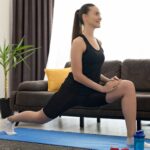Table of Contents
Are you thinking about coming back to your training regime but you’re not entirely sure what to do?
Or maybe you are already in the rhythm but thinking about adding some variety to your routine?
You are in the right place. In this article, I will give you a few tips on why exercising over your 40s is even more important than when you’re in your 20s.
I will also guide you on the most effective movements for which your body will be thankful.
Follow along!
Working Out Over 40
As you get older, your fitness goals and needs change.
When you are in your twenties, most probably you want to look good and impress others with your physique. But when you are in your forties, you definitely want to be functional and strong to be able to play with your kids and simply enjoy life.
That is why it is important to take care of the body on a daily basis. Focus on improving your range of motion and body mechanics. Especially when it comes to hip and shoulder mobility.
There are essentially few movements or body postures that you want to cultivate as you age. Think about it. You want to carry heavy stuff, run, jump, squat and lean forward. These are the everyday moves that you need to perform various tasks, such as lifting your kids, hiking or running to your car, or squatting to grab a bag of groceries.
By working on these movements, you can improve your fitness, health, and quality of life. So which exercises will help you achieve your goals?
Best Exercises
Do you want to stay injury-free, gain muscles and be strong in your life?
Do you want to improve your fitness, health, and performance?
You need to include the following moves into your training routine: squats, deadlifts, standing or sitting presses, and bench presses.
These exercises are easily accessible. You can do them in your home gym or in a regular gym, whichever way you prefer.
These classic movements may seem simple at first glance, but they are super effective and time-tested. They will help you build a strong and muscular body that can handle any challenge in life.
Squats
Squats are probably the most basic move to work on in order to strengthen your lower body. They target your quads, hamstrings, glutes, and calves, as well as your core and back muscles. Just one move with potential for developing muscles in your whole lower body.
There are numerous ways you can squat, depending on your goals, preferences, and equipment. You can squat with your bodyweight, which is an excellent, super accessible option, especially when you travel. Bodyweight squats can improve your mobility, balance, and endurance.
If you choose a barbell, then your options would be front or back squats. Front squats seem a little bit more quads dominant compared to the back squats, due to the upright position. In general, barbell squats are the most efficient way to target your legs, as they allow you to lift heavier weights and stimulate more muscle growth.
If for some reason you choose other variations like double-kettlebell front squats, you most probably would have to compensate for the lower weight and focus on more reps. On the other hand, squatting with kettlebell squats can challenge your stability, coordination, core and upper body strength.
At the end of the day, no matter what type of squat you choose, make sure you perform it with proper form and technique to avoid injuries and maximize results.
Deadlift
Deadlifts are a must for anyone thinking about strong back and legs. Next to bench press and squat, they belong to the big 3 lifts and are arguably the most important one.
It’s a compound move. You will work multiple muscle groups at once. I would recommend doing deadlifts as the first exercise in your workout and then slowly move to isolation exercises when you are a little more tired.
Deadlifts are amazing in improving your posture, as they generally work on your whole posterior chain, which includes your lower back, glutes, hamstrings, and calves.
They also work on your hips, traps, and core, which are essential for stability and balance. When you get older, it is super important to take care of your hip mobility. Probably nothing is better than deadlifts since it’s the hip dominant move.
Deadlifts can also help you prevent injuries, improve your performance, and increase your confidence. Of course, always remember about the proper form and technique to avoid hurting yourself.
If for some reason you want to avoid this powerful and raw move, there are some alternative options that can still work on similar muscles.
The most common are sumo deadlifts, suitcase carries, kettlebell swings, or simply back extensions. However, I would suggest you give the classic deadlift a try and then think about alternatives.
Bench Press
Bench press is probably the most popular weightlifting exercise, and for a good reason.
It is another compound movement that hits multiple muscles at once, such as your chest, shoulders, triceps, and even your back and core.
It is also the strongest lift you can perform with your upper body, so if you are looking for hypertrophy in your chest and front delts, it is the best choice.
As with all exercises, there are numerous variations you can work with when pressing on the bench. First of all, the position of your bench will determine the parts of your pecs you will hit.
Incline bench will work on your upper chest, while decline bench will work on your lower chest. If for some reason you do not want to use a barbell, feel free to reach out for dumbbells, for example.
You will not probably lift as much with them, but you will free up your hands and this will help you avoid possible injuries or pain in your shoulders.
And yes, do not forget about push-ups. They are a perfect alternative to bench press, super safe and highly accessible. You can do them anywhere and anytime, and adjust the difficulty by changing your hand position or elevation.
Lunges
Lunges are a powerful exercise that will hit your entire lower body. You will train your quads, hamstrings, and glutes, which are the main muscles responsible for your movement and power.
You will also develop your coordination and balance, especially when you add kettlebells or dumbbells to the move. Adding weight will increase the intensity and challenge of the exercise, as well as your core stability.
There are a few types of lunges that you can focus on in your workouts, depending on your goals and preferences. The most common are walking lunges, where you step forward with one leg and lower your body until both knees are bent at 90 degrees.
Holding a kettlebell or a dumbbell in each hand during the exercise is an amazing way of developing your quads and glutes. In general, walking lunges will work on your entire lower body, as well as your cardiovascular endurance.
With side lunges you will move your leg to the side instead of to the back. Side lunges will target the same muscles as the classic ones, but they will also work on your inner thighs.
How often should I train?
Very good question. Start with 3 sessions per week, no longer than 30 min each. Then slowly increase to 4 workouts per week. Remember to ALWAYS warm your body up, especially when you get older. It’s probably the most overlooked and underrated part of every training.
Remember that recovery, good nutrition and the proper amount of sleep is equally important on the path to strength, bigger muscles and longevity.


